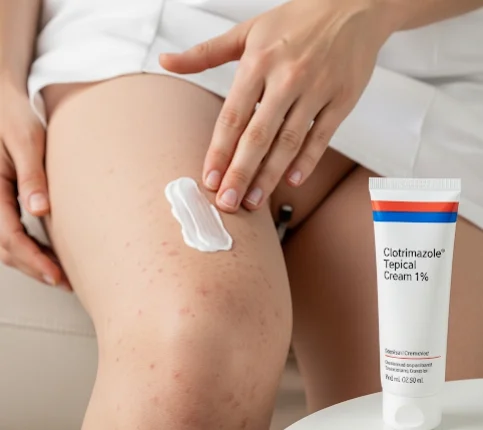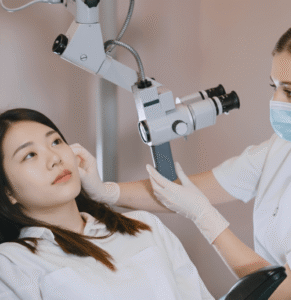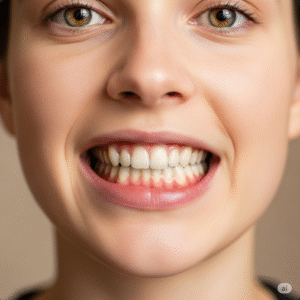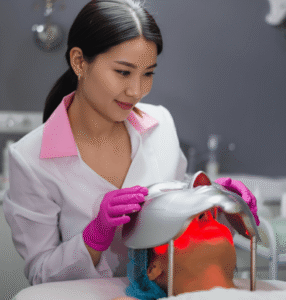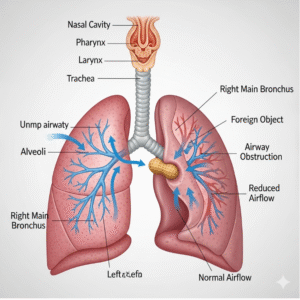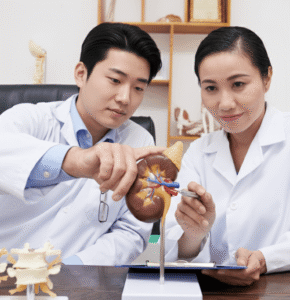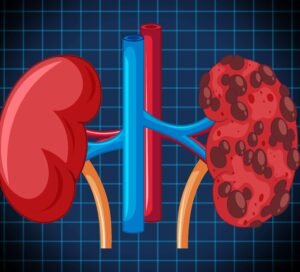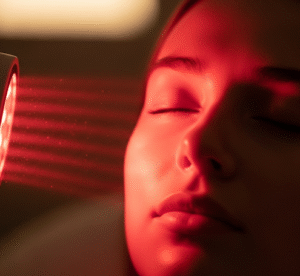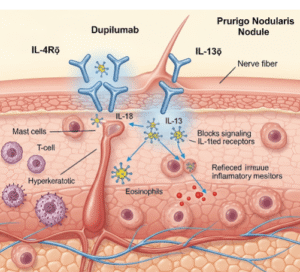➤ What it is
Tinea Cruris, commonly known as jock itch, is a fungal infection that affects the groin area, inner thighs, and buttocks. It is caused by dermatophyte fungi, primarily Trichophyton rubrum. The warm, moist environment of the groin makes it an ideal breeding ground for fungal overgrowth.
The infection appears as itchy, red, ring-shaped rashes with raised, scaly edges and a clearer center. It may spread to adjacent areas if untreated. Unlike bacterial infections, tinea cruris is not dangerous, but it is highly uncomfortable, contagious, and often recurrent.
In Korea, tinea cruris treatment is approached with a focus on fast fungal eradication, comfort restoration, and cosmetic skin recovery. Dermatologists often combine antifungal therapies, supportive skincare, and preventive counseling to ensure both medical and aesthetic outcomes.
➤ Why it’s done
Treating tinea cruris is essential for:
- Medical Resolution → Prevents the fungus from spreading to other areas or individuals.
- Symptom Relief → Reduces itching, redness, burning, and discomfort.
- Preventing Complications → Stops secondary bacterial infections due to scratching.
- Avoiding Recurrence → Proper treatment minimizes relapses.
- Cosmetic and Social Confidence → Clears visible rashes and restores healthy skin tone, which is important in Korea’s skin-conscious culture.
➤ Alternatives
Multiple therapies are available depending on severity and extent:
Topical Antifungals (First-line for Mild to Moderate Cases)
- Azoles (clotrimazole, miconazole, ketoconazole).
- Allylamines (terbinafine, naftifine, butenafine).
- Ciclopirox creams.
- Applied 1–2 times daily for 2–4 weeks.
Oral Antifungals (Moderate to Severe or Recurrent Cases)
- Terbinafine tablets.
- Itraconazole or fluconazole courses.
- Used when topical therapy fails or the infection is widespread.
Supportive & Preventive Approaches
- Medicated antifungal powders or sprays to keep the area dry.
- Moisture-wicking clothing to reduce sweating.
- Korean herbal soaks (green tea, mugwort, bamboo) sometimes used as soothing adjunctive therapies.
Observation
- Rarely recommended; fungal infections almost never resolve on their own.
➤ Preparation
Proper preparation ensures effective tinea cruris treatment:
- Diagnosis Confirmation
- Dermatologist exam and sometimes KOH microscopy of skin scrapings.
- Helps differentiate from eczema, psoriasis, or intertrigo, which look similar.
- Skin Hygiene
- Wash affected areas daily with mild cleansers.
- Dry thoroughly, especially in skin folds.
- Avoid applying steroid creams (they worsen fungal infections).
- Lifestyle Preparation
- Wear breathable cotton underwear.
- Avoid tight clothing and prolonged moisture exposure.
- In Korea, clinics sometimes start patients with pre-treatment cleansing and soothing sessions to reduce irritation before antifungal therapy.
➤ How it’s Done
Tinea Cruris Treatment in Korea involves a stepwise, integrated approach:
1. Topical Therapy
- Antifungal creams applied once or twice daily.
- Continued for at least 1–2 weeks after symptoms resolve.
2. Oral Therapy (If Needed)
- Oral antifungals prescribed for stubborn or extensive infections.
- Dosing monitored carefully to minimize side effects.
3. Supportive Korean Dermatology Care
- Antifungal washes with medicated cleansers used in the groin area.
- LED blue light therapy → sometimes used in clinics to reduce fungal activity and inflammation.
- Soothing facials for body skin → hydration masks or herbal compresses applied to reduce irritation.
4. Preventive & Lifestyle Programs
- Daily use of antifungal powders.
- Counseling on hygiene, clothing, and gym habits.
- In Korea, dermatology clinics often provide personalized skincare and lifestyle coaching to ensure long-term prevention.
➤ Recovery
Recovery depends on the extent and treatment adherence:
- Mild to Moderate Cases
- Topical therapy clears lesions in 2–4 weeks.
- Itching usually improves within days.
- Severe Cases
- Oral antifungals may take 4–6 weeks.
- Pigmentation changes can linger temporarily.
Aftercare Guidelines:
- Keep the groin dry at all times.
- Change clothes and underwear daily.
- Wash towels and linens regularly.
- Avoid sharing personal items.
Korean Recovery Practices:
- Dermatology clinics often provide post-treatment soothing creams or tone-correcting skincare to reduce residual dark or light spots.
- Regular follow-up visits ensure recurrence is caught early.
➤ Complications
Untreated or improperly managed tinea cruris can lead to:
- Chronic or recurrent infection → very common without preventive care.
- Secondary bacterial infections from scratching.
- Spread to adjacent areas (buttocks, thighs, feet).
- Pigmentation changes → post-inflammatory hyperpigmentation or hypopigmentation.
- Tinea incognito → fungal infection worsened by steroid cream misuse.
Korean dermatologists minimize complications by using precise antifungal therapy and offering cosmetic solutions for pigment changes.
➤ Treatment Options in Korea
Korea has developed an advanced approach to fungal skin care, making tinea cruris treatment highly effective.
Why Korea excels:
- Rapid diagnostics with KOH microscopy and cultures widely available.
- Combination care → antifungal therapy plus aesthetic soothing treatments.
- Barrier repair focus → ensuring skin heals evenly after infection.
- Preventive counseling → personalized hygiene and skincare guidance.
Unique Korean Practices:
- Antifungal facials for body skin → specialized treatments that cleanse, calm, and restore skin tone.
- LED therapy for groin dermatitis → reduces fungal overgrowth and inflammation.
- Pigmentation management programs → tone-correcting skincare after fungal clearance.
- Integrated dermatology clinics → where fungal treatment is combined with long-term cosmetic skin care.
✨ Final Thoughts
Tinea Cruris Treatment in Korea goes beyond simply clearing a fungal infection — it represents a comprehensive, medical-meets-cosmetic approach. With topical and oral antifungal therapies, combined with supportive skincare programs and preventive strategies, Korea ensures patients not only achieve fungal clearance but also restore healthy, even-toned, and comfortable skin.
This holistic approach, with its focus on prevention, long-term skin health, and cosmetic outcomes, makes Korea a global leader in managing fungal infections like jock itch.

